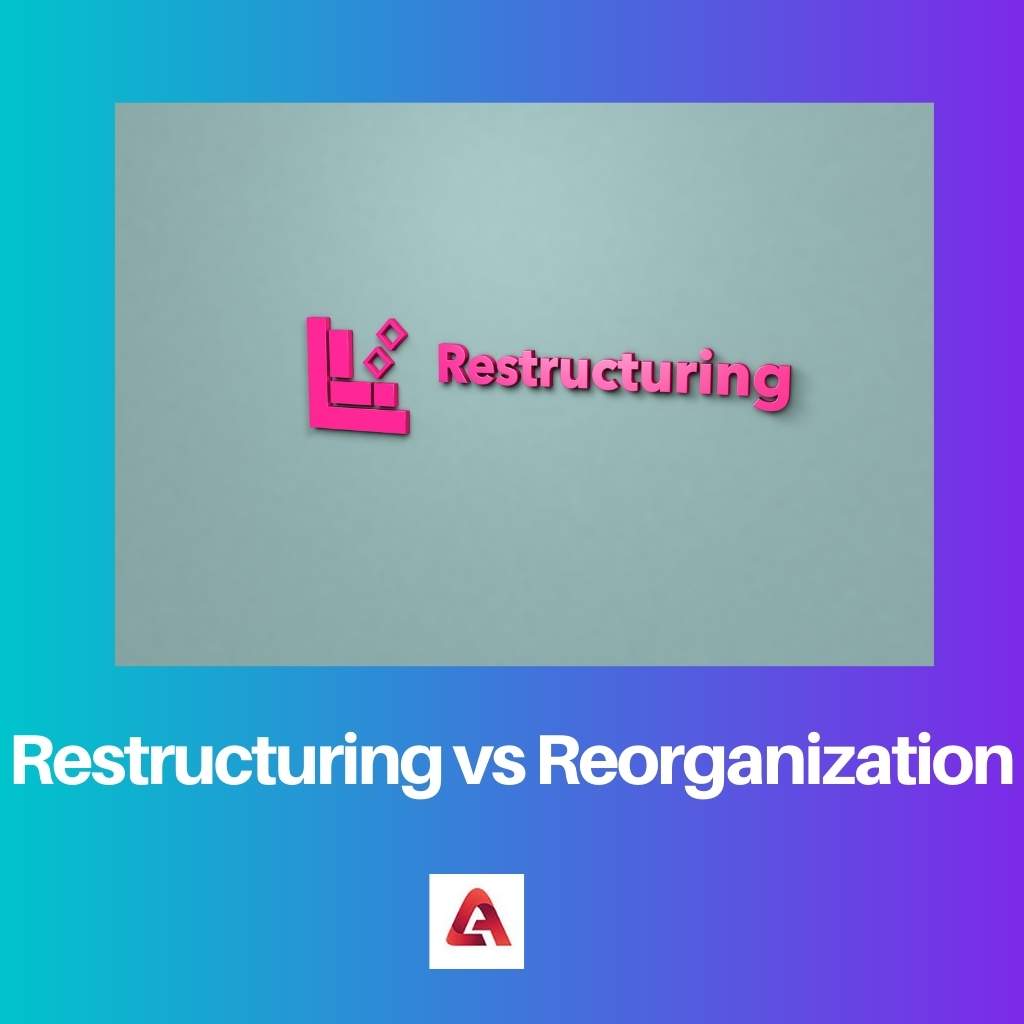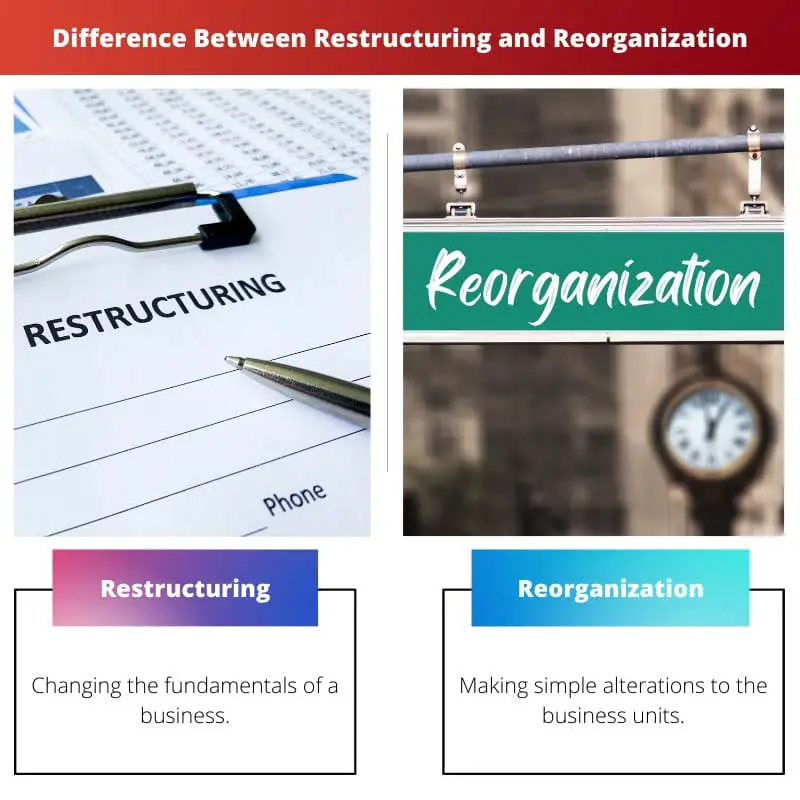It is common to hear words such as restructuring and reorganization are thrown around when a person works in a corporate environment.
These are a few terms that might confuse the average English speaker working in such environments. Hence, it is essential to understand the differences between the phrases like restructuring and reorganization.
Key Takeaways
- Restructuring involves changing the organizational structure, processes, and operations to improve efficiency and reduce costs. In contrast, Reorganization involves making significant changes to the entire organization to adapt to new business environments, strategies, or mergers and acquisitions.
- Restructuring is aimed at addressing immediate issues, whereas Reorganization is a long-term strategy that involves a major shift in the organization’s direction.
- The restructuring may involve downsizing, layoffs, or outsourcing, whereas Reorganization may involve changing the organizational culture, vision, and goals.
Restructuring vs Reorganization
Restructuring is a term that is used to describe the act of changing the fundamentals a business is used to and replacing them with new conditions or an entirely new environment. Reorganization is the process of making a few altercations and modifications to the way a business is handled.

The word “Restructuring” is quite used in corporate areas. In practice, this term defines the process of changing a business’s fundamentals to adapt to newer conditions or environments.
This act is performed to push an organization to become profitable and able to compete with the current competition in the market.
The word “Reorganization” is another business terminology that can be heard in a company’s surroundings. Organizations tend to use the method of reorganization to stabilize a company without making any significant changes.
It allows an organization to clear up and organize its work better and more effectively.
Comparison Table
| Parameters of Comparison | Restructuring | Reorganization |
|---|---|---|
| Meaning | Changing the fundamentals of a business. | Making simple alterations to the business units. |
| Reason | To make a company more efficient and competitive. | To make a plan or campaign more effective. |
| Hiring | Recruits in different positions are hired. | No recruits are hired. |
| Period | It is performed with a long-term vision. | It is performed for a short-term goal. |
| Importance | Significant changes are made to the business. | Insignificant but required changes are made to the plans. |
What is Restructuring?
Restructuring is a common term that is used in the corporate field. It means changing the process of fundamentals of a business. A company may use the term restructuring when it aims to adapt to newer conditions or a new environment.
Restructuring is also used when a company plans to yield better profit and compete with its competitors in their field of business.
During the restructuring process, a company may hire different resources. The restructuring of a business organization is performed with a long-term vision.
It plays an integral role in the business. The restructuring also includes completely changing the base structure of a business organization.
It also involves modifying the operations part of a company. Some of the types of restrictions include merging and acquisitions, divestment, legal restructuring, reduction of cost, and adapting to new methods in operations.
As you can notice, all these are some of the major game-changers in the company’s life cycle. That is why the restructuring process in a business organization is said to have a long-term vision.
Organizational restructuring is one tough process as the company should consider its present condition, competitors, the trend and many factors before restructuring the process.
What is Reorganization?
Reorganization is nothing but making few and very simple alternations to the business organization. Unlike restructuring of an organization (as it involves a hefty process), reorganization involves simple steps.
Reorganization is undertaken as a means to make a plan or a campaign organized by the business organization more effective.
A reorganisation process is initiated when the company is not in a proper condition and finds it difficult to meet ends. Reorganization can be the selling of units of a business or cost minimization, or terminating a company’s workers.
A company on the verge of bankruptcy may be to submit a reorganizational plan to revive the business organization from financial crises.
The reorganizational plan may include big changes in the company, such as replacing the management or reducing the budget, or selling of different divisions of the business organization.
In the worst-case scenario, if the reorganizational plan of a business organization fails, then the assets of the company are sold and used for settling the debts created by the company.
Some of the major changes involved in the reorganization of a company are changing the name of the company, spinoff acquisition, or replacing the management of the company.
Both the reorganization and the restructuring are a company’s major game-changer.
Main Differences Between Restructuring and Reorganization
- Restructuring is performed by changing the fundamentals or base structure of a business. Reorganization is performed by doing low-level modifications to business units.
- A company’s efficiency and competitiveness can be transformed by restructuring. A business’s plans or campaigns can succeed by clear and effective reorganization.
- The restructuring process involves hiring recruits from the CEO to the employee. The method of reorganization does not require any recruitment.
- A company’s long-term vision plays an influential role in the process of restructuring. Short-term goals are achieved by reorganizing the business’s units.
- Restructuring involves significant changes to a business’s basic ideas and fundamentals. Reorganization makes necessary alterations but does not include any significant changes.


This article provides a comprehensive overview of restructuring and reorganization, highlighting the differences and implications of each strategy in a business context.
The distinctions between restructuring and reorganization are clearly outlined in this article, providing a detailed comparison that is beneficial for those seeking a deeper understanding of these concepts.
The differentiation between restructuring and reorganization in terms of the purpose, hiring, period, and importance is made clear in this article. It’s really helpful to have such a detailed comparison.
Your comment is very insightful and further emphasizes the importance of these distinctions.
I appreciate the clear definitions and examples that are provided to illustrate restructuring and reorganization. It’s helpful to have concrete examples to understand these concepts.
The comparison table really highlights the key distinctions between restructuring and reorganization in a clear and concise way. It’s really helpful for anyone trying to understand the nuances of these terms.
This article sets out a clear distinction between restructuring and reorganization and the different approaches they each involve. It’s clear that the main difference between the two is the degree of change each entails. While restructuring is more about fundamental changes, reorganization is about smaller, but significant changes.
Absolutely, your comment does a great job of summarizing the key differences and significance of these terms.
I agree with your comment. These are very important concepts to understand in the business world.
The detailed explanations of restructuring and reorganization provided in this article are very helpful in understanding the significance of these terms in business contexts.
The references provided at the end of the article add credibility to the content and allow for further exploration of these concepts. It adds depth to the discussion on restructuring and reorganization.